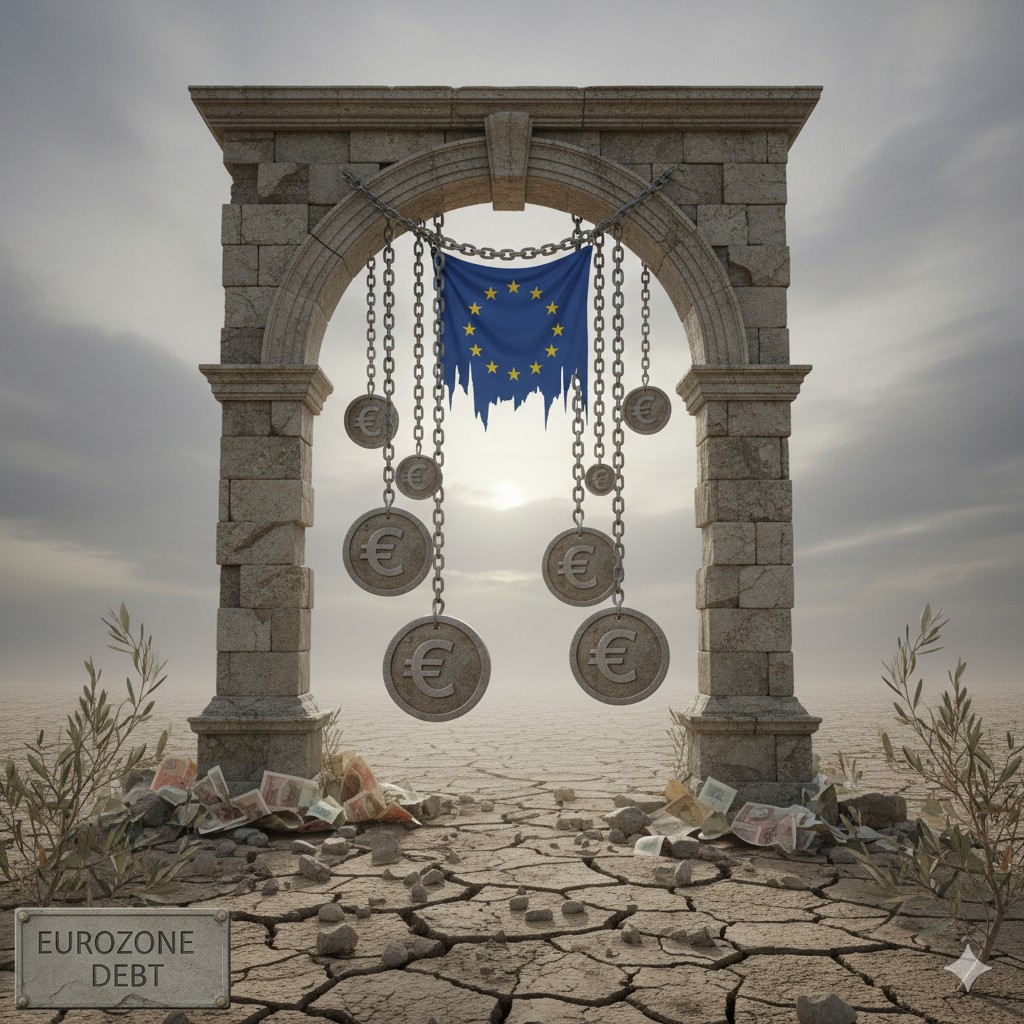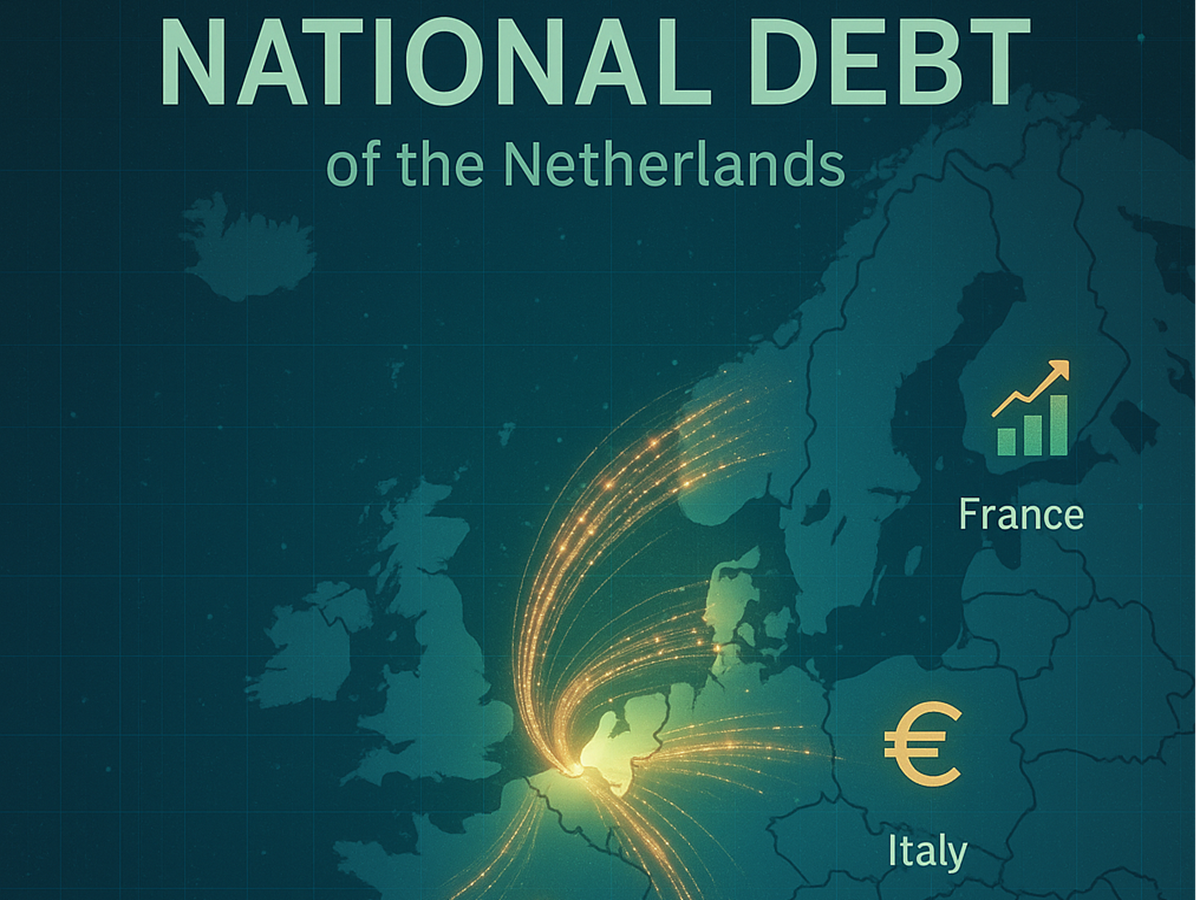The Hidden Debt Time Bomb in the Eurozone — Expanded Analysis
With the euro area’s debt reaching 88 percent of GDP, Europe confronts a perilous mix of weak growth, rising rates, and fractured politics that threaten fiscal stability.

Introduction
By the end of the first quarter of 2025, the euro area’s combined public debt had climbed to 88.0 percent of GDP, up from 87.4 percent in the previous quarter — and reversing a modest downward trend. :contentReference[oaicite:0]{index=0} Meanwhile, the European Union (including non-euro members) saw its average government debt rise from 81.0 percent to 81.8 percent of GDP. :contentReference[oaicite:1]{index=1}

At first glance, these numbers may not sound catastrophic — many advanced economies carry high debt ratios. But embedded within these aggregates lie fragilities, divergences, and political risks that could amplify small shocks into broader crises. With economic growth sluggish, borrowing costs inching upward, and the stability of fiscal rules under contest, Europe stands at a crossroads.
Disparate Realities Behind the Aggregate
One of the core tensions is that the aggregate debt figure masks stark differences across member states. In countries like Italy (≈ 137.9 % of GDP) and France (≈ 113 %), the debt burden is enormous — magnitudes higher than in fiscally safer states. :contentReference[oaicite:2]{index=2} In contrast, nations such as the Netherlands or Estonia maintain far lower ratios — making them less exposed to debt stress, but also less central to discussions around rescue or solidarity.
But size is not everything. The cost of servicing debt, the maturity structure, currency exposure, and creditor confidence all matter. For example, if a high-debt country has mostly short-term debt or relies heavily on volatile markets, a small interest-rate rise or shift in investor sentiment can trigger sharp tightening.
Growth’s Weak Grip, and the Debt–Interest Tradeoff
Debt is sustainable when growth helps absorb or outpace borrowing costs. But Europe’s growth outlook is anchored in mediocrity. The European Commission’s Spring 2025 forecast estimates 1.1 percent growth for the EU and 0.9 percent for the euro area. :contentReference[oaicite:3]{index=3} The IMF’s broader data shows comparable low rates — meaning that recovery is fragile and any external shock (trade, energy, geopolitics) can knock the continent off course. :contentReference[oaicite:4]{index=4}
Now imagine interest rates creep upward — either globally or domestically. For countries already carrying high debt, every additional basis point in yield translates into millions or even billions more in interest payments. The burden grows nonlinearly: high debt → higher risk premium → higher rates → even heavier burden.
Some academic models note that when nominal interest rates r exceed nominal growth rates g, debt dynamics turn precarious unless the primary fiscal balance is strongly positive. :contentReference[oaicite:5]{index=5} In plain terms: if you borrow faster (via interest) than your economy expands, you need budget surpluses just to stabilize — a heavy ask in strained times.
Reformed Fiscal Rules: A New Regime, Fragile Credibility
In April 2024, the EU adopted a revamped fiscal framework intended to replace the long-criticized old rules. :contentReference[oaicite:6]{index=6} Under this regime, countries must present medium-term fiscal structural plans (MTFSPs), with rules on “net primary expenditure” and debt sustainability analyses (DSAs) to guide trajectories. :contentReference[oaicite:7]{index=7} The idea: countries with debt over 90 % of GDP must reduce debt by at least 1 percentage point annually, while those between 60 % and 90 % must reduce it by 0.5 p.p. :contentReference[oaicite:8]{index=8}
However, credible enforcement remains an open question. During the transition, many countries exploited ambiguities — overlapping phases of old and new surveillance — to stretch fiscal space. :contentReference[oaicite:9]{index=9} Moreover, some member states lobbied for flexibility, resulting in the Council activating escape clauses for defense spending in 15 states. :contentReference[oaicite:10]{index=10}
Germany, in particular, reformed its national “debt brake” in 2025: it created a € 500 billion infrastructure fund excluded from borrowing limits and loosened constraints for defense spending. :contentReference[oaicite:11]{index=11} Critics argue this raises tensions with EU rules, especially since Germany is a key rule-maker. :contentReference[oaicite:12]{index=12}
All told, the new framework’s ambitions are high: gradual, growth-friendly consolidation, protecting investment in green/digital transitions, and more predictable governance. :contentReference[oaicite:13]{index=13} But success hinges on enforcement, political will, and the ability to change assumptions (e.g. on aging costs, trend growth) over time. :contentReference[oaicite:14]{index=14}
Political Fault Lines and Market Sentiment
Debt isn’t just a macro variable — it has politics woven through it. Countries under pressure often face pushback from voters against austerity or tax hikes. Recent episodes in France, where political instability cut growth, illustrate how fiscal stress and politics feed off each other. :contentReference[oaicite:15]{index=15} In Germany, the altered debt rules and rising defense commitments reflect shifting political priorities. :contentReference[oaicite:16]{index=16}
Rating agencies are watching. As political risk increases, they may demand higher spreads for affected sovereigns — further worsening the vicious cycle. Some analysts warn that risk premia in sovereign bonds remain underpriced for many EU states. :contentReference[oaicite:17]{index=17}
Another wild card is contagion. Suppose markets lose confidence in Italy or France. The shock could ripple to peripheral states (e.g. Portugal, Greece, Spain) or even to core states if confidence fractures. The European Central Bank (ECB) has tools — such as the Transmission Protection Instrument (TPI) or Outright Monetary Transactions (OMT) — but their deployment is politically fraught. :contentReference[oaicite:18]{index=18} Some fear that by the time support is politically viable, stress may already have cascaded. :contentReference[oaicite:19]{index=19}
Alternate Paths and Shock Scenarios
The hypothetical becomes more pressing when stress arises. Let’s consider a few scenarios:
- Moderate interest shock: A 50 bps increase in sovereign yields strains high-debt countries. Some may delay repayments, causing spreads to widen further.
- Growth unexpectedly falters: Suppose GDP growth slips to 0.3 %; then revenue shortfalls force spending cuts or fresh borrowing — both politically risky.
- Political realignment: If a government collapses mid-cycle (as seen in France), confidence wanes, and bond markets may retract sharply.
- Synchronized stress: If multiple high-debt countries suffer pushes in yields, the ECB’s backstop capacity may stretch, forcing difficult choices across the bloc.
These scenarios vary in severity, but each underscores that debt is not just a burden — it is a lever of instability when the buffers are thin.
Strategic Options for Europe
Europe has some levers to manage this pressure — but timing, credibility, and coordination are key.
- Reforming the fiscal rules again, but sustainably: The current rules are imperfect. Some economists call for adjustments to DSA assumptions (aging, productivity) or longer adjustment periods. :contentReference[oaicite:20]{index=20}
- Joint borrowing & fiscal backstops: Instruments like “eurobonds” or a permanent joint debt vehicle — perhaps tied to investment in green/defense — can help share risk. Yet moral hazard, governance, and political consent remain obstacles. :contentReference[oaicite:21]{index=21}
- Growth as medicine: Investment in innovation, digital infrastructure, green transition, labor reform — especially in lagging countries — can boost long-term growth and relieve pressure. :contentReference[oaicite:22]{index=22} But these investments often require upfront borrowing, and political patience is fragile in downturns. :contentReference[oaicite:23]{index=23}
- Selective tightening with priorities: Some tightening or reprioritization may be inevitable — but governments must protect critical social and investment spending to avoid stagnation or backlash.
- Strengthening crisis tools: Enhancing the speed, clarity, and conditions for ECB backstops (TPI / OMT), including pre-approved triggers, could reduce market uncertainty in stress episodes.
Case Spotlight: Italy and Germany
Italy, with its ~138 % debt ratio, remains the poster child for risk in Europe. :contentReference[oaicite:24]{index:24} The country’s growth has been weak, and its political volatility is frequent. Any shock to yields or sentiment could reignite crises. Indeed, Italy’s public debt recently passed €3 trillion — the highest level ever. :contentReference[oaicite:25]{index=25} The challenge for Italy is that it operates at the limits: little room for flexibility, high exposure, and near-constant market scrutiny.
Germany, in contrast, is often seen as the bloc’s stabilizer — but recent actions suggest it is drifting into more aggressive fiscal territory. In 2025, Germany reformed its national fiscal framework, allowing a large infrastructure fund outside the standard debt limits and easing borrowing for defense. :contentReference[oaicite:26]{index=26} Meanwhile, the German Stability Council now forecasts debt exceeding 80 % of GDP by 2029. :contentReference[oaicite:27]{index=27} Such moves raise important questions: if the supposed anchor nation shifts its stance, can the rest of the eurozone hold to stricter constraints?
Conclusion
The eurozone debt load is no longer merely a statistic to monitor — it has become an implicit fault line. Each percentage point in debt, each basis point in yield, each tenth of growth lost — they compound. With growth weak, rules fragile, and politics volatile, Europe must decide whether to rely on flexibility and coordination, or risk fragmentation under stress.
In the coming years, the urgency of these choices will intensify. Crises seldom arrive on neat schedules — they erupt when least expected. For Europe, the question is not whether debt will matter, but when and where the next crack will open.
More articles
Related EU debt and fiscal insights to explore next.

20 Nov 2025
Ranked: The European Countries Where Every Citizen Owes Over €50,000
Forget the Debt-to-GDP ratio for a moment. When we look at the raw debt burden per citizen, a new and surprising map of Europe emerges. We rank the EU-27 by debt per capita.

11 Nov 2025
Can the US Handle More Debt Than Europe?
Several EU countries are already above 100% debt-to-GDP, just like the United States. Yet markets treat US debt very differently. This article explains why.

07 Nov 2025
Europe's Trillion-Euro Question: When Is National Debt an Investment?
As Europe faces the colossal costs of the green and digital transitions, the old rules of austerity are being challenged by a new logic: borrowing not for consumption, but for survival and future growth.

05 Nov 2025
The 'Swedish Wonder': National debt is falling and the live tracker is green
In an EU where most national debts are rising, Sweden is doing the opposite. With a debt ratio of just 34% and a declining counter, we look at how the 'top of the class' manages this outside the Eurozone.

01 Nov 2025
Ticking Up by €118/Second: Is the Netherlands Still Europe's 'Frugal' Leader?
The Dutch national debt is rising by €118 every second. While its 42.7% debt-to-GDP ratio remains well below the EU limit, this live tracker reveals a more complex picture compared to its European neighbors.

25 Oct 2025
Europe’s Debt Thermometer, Q2 2025: Who’s Up, Who’s Down — and Why It Matters
New Eurostat data for Q2 2025 reveals a Europe moving in two directions: while some countries’ debt-to-GDP ratios climbed, others managed to bring them down. Here’s what’s driving the shift beneath the surface.